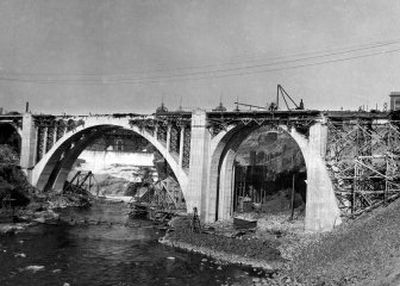TREASURE HUNT

It was a weekend of parties.
From all over the city, people came out to celebrate the reopening of the Monroe Street Bridge.
The excitement went beyond basic relief that a major north/south arterial was flowing freely again. There was also the air of a “welcome home” party for a member of the family who has been gone too long.
As a relative newcomer, I enjoyed the enthusiasm all around me. I don’t have a long history with the bridge, but I’ve discovered it doesn’t take long to learn to appreciate it.
The first time I saw the rushing water under the wide single-span arch, in the spring of 1999, I was impressed.
It’s impossible not to be.
Because I live outside of the city, I depended on the bridge to carry me downtown, past all the shops and interesting places I was starting to explore. When it was taken out of service, like everyone else, I made the wide loop around the construction.
Then, when I went to work full time, I navigated around it twice a day, driving in the throng of cars that had been re-routed.
Watching the progress, and counting down the days to reopening, I was ready to celebrate, too.
Friday night I cashed-in a number of missed nights on the town, nights when I had been too tired for dinner and a movie or had had to sacrifice my own fun for a child’s schedule, and joined the party on the bridge.
I wanted to get out and have a good time, and I did. But, I also wanted to be a part of Spokane’s history, something I haven’t really had many chances to do.
There were a few souvenirs; a wine glass and a booklet detailing the history of the bridge, but the memento I brought home with me was intangible.
From where I was sitting, beneath a tent filled with tables covered in white linen, I could see the length of the bridge facing north.
The concrete was pale and new. Along the span of the bridge, reproduction globe-topped street lights cast circles of light onto the deck.
A row of vintage cars of different eras was parked to the side, just under the lights. Some of the partygoers were dressed in vintage clothing.
The combination of the darkness surrounding the bridge, the soft pools of light under the streetlights and the costumes gave an eerie effect.
I watched a man, dressed in a tuxedo and a top hat stroll past a vintage car from the 1920s. It was easy to imagine for just a moment, as he walked slowly along, that he belonged to the car and to the era from which it had come.
A few minutes later a man wearing a fedora and holding a camera took a photograph. I saw the flash, and his silhouette, and he looked the way a newspaper photographer from an old 1940s black-and-white movie might have looked.
As I sat there, watching quietly, a couple moved toward me. She was wearing an elaborate Edwardian costume and the man wore an elegant tuxedo and white vest. Their posture was erect and regal, as befitted their clothing. My eyes followed them as they moved gracefully by.
I enjoyed the party. It was a chance to meet people and celebrate the return of an important piece of Spokane’s history, and it was fun to finally get a night out.
But, although I didn’t say it aloud to anyone, what I enjoyed the most was the chance to suspend belief.
With the help of flesh and blood people, I was caught in the spell of the ghosts of the men and women who have traveled the bridge that has connected the two halves of our city for almost 100 years. Who knows, in another century, when the city builds a new bridge into the future, perhaps my spirit will be there too, just out of sight in the shadows.
Monday morning, on my way to work, I drove across the bridge for the first time in more than two years.
There were no ghosts. Just a line of happy commuters.